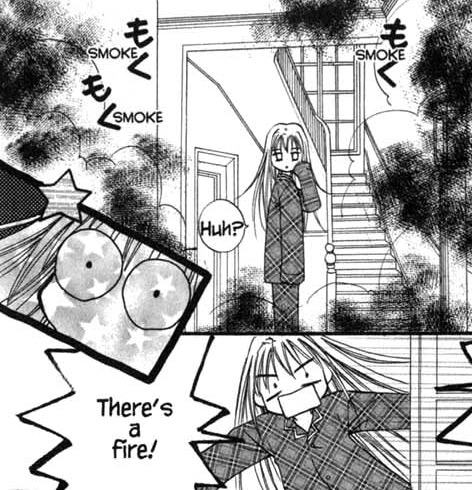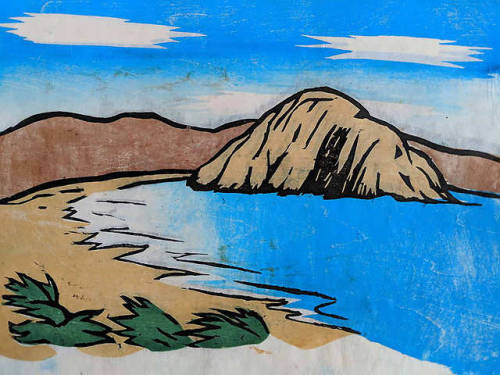

To print, the artist uses a baren, a flat, hand-held disk that is wrapped in a bamboo sheeth, to press the pigment into the paper.
EXAMPLES OF MOKU HANGA REGISTRATION
A sheet of sized and dampened paper is then placed on the block proper alignment is insured by two registration marks that are carved into each block at the same place. Pigment dispersed in a water and rice paste are placed on the block and smoothed across the surface with a brush that looks similar to a shoe brush. Areas that are not to be printed are cut away, leaving a raised surface, as in the principle of a stamp. Initially, the artist carves a block of wood for each color to be printed. To move from the inspiration of the sketch to the mechanics of the print requires thoughtful organization of color and space. The process, however, is labor intensive for the artist, who must undertake the roles of designer, carver, and printer. Wood, water, paper, pigment, paste, and simple carving and rubbing implements are all that is needed to make a print. The best moku hanga artists have learned the skills of carving and printing from experienced artists like for instance Toshi Yoshida or Tokuriki Tomikichiro or Seki Kenji. The plays are also recognised as influential examples of the aragoto (rough style) genre of kabuki theatre.

EXAMPLES OF MOKU HANGA SERIES
Now you can try your own versions of colours or you can enhance edges to a greater degree.Japanese woodblock printmaking, moku (wood) hanga (print), is distinguished from other printmaking techniques by the simplicity of material involved in its creation. Description: The eighteen kabuki plays in this series were chosen and compiled by actor Ichikawa Ebiz V (Ichikawa Danjr VII) as the best plays associated with the Danjr line of actors. Over the years he has had numerous one-man shows and has exhibited at the Virginia Museum of Fine Arts in Richmond and in the Adirondacks National Exhibition of American Watercolors. Here, I'm going to use a set of continuous colours, but I'm reducing their possible color-range, "HSB"] His primary medium is moku hanga, the traditional Japanese way of making color woodblock prints. I mention this function since it can easily be used if you want to artistically recolour the image. Cornwall based artist Adrian Holmes tests the Jackson’s Curated Set for Moku Hanga Printmaking and shares his thoughts on each of the materials included and how suitable the set is for beginners to this method of Japanese printmaking. What it does is that it replaces colours in an image with a set of predefined colours and chooses the ones that are close together. Breathtaking landscapes, beautiful women, and busy cityscapes can all be transformed into this exotic art form known for its flowing hand-chiseled outlines and brushed on color. The other good book on the same topic is by Rebecca Salter. The photographs and text are both very clear and there are some great examples from a variety of artists. Put not as easy to use as a reference as others but that also makes it much more readable. Let me self-promote my answer here and use the function therein. Moku Hanga Transform a Photo into a Painted Japanese Wood Carved Scene You have discovered the fascinating art of Moku Hanga, the Japanese method of wood-block printing. Moku Hanga by Ryusei Okamoto Ryusei Okamoto born 1949 Item 86553 Title Venice - Evening view Sold 240 - Auction ending in 2 days, 15 hours, 47 minutes and 48 seconds. This is the book that got me started doing Moku Hanga. There are several ways of doing this and you can look at ColorQuantize or ImageEffect. Here, we only care about the colours in the image and try to transform them into what looks pleasing by simultaneously reducing their number.

The term ‘woodcut’ covers the majority of European usage of the technique on paper. should be replaced by "artistic recolouring", but for the sake of your beer cans, let's try to imitate what the app did. The most well-known type of Japanese woodblock art print technique is called moku hanga which employs watercolour pigments rather than oil-based inks. It seems not uncommon that they used rather vivid colours, so step 2. In the West, the most famous examples of Japanese woodblock prints have originated from the Edo-period (16001868). In a final step, the black outline is printed. If you read how such Moku Hanga are made, you find that there are several layers carved into wood that are coloured and printed over another. enhancing and blackening of image edges.I can identify at least 4 steps the dedicated app is performing:


 0 kommentar(er)
0 kommentar(er)
